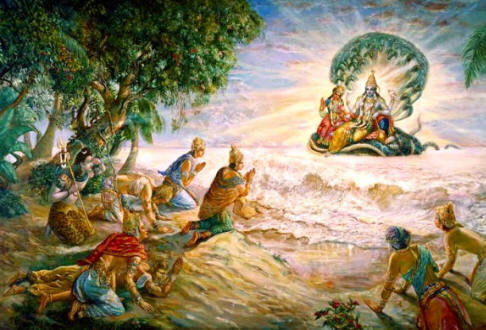Published from “Three Minutes” series written by A.S.Rajagopalan Swami of Ohio.
imaiyOrgaL kuzhAm tozhuvadum sUzhvadum sey tollai mAlaik kaNNArak kaNDu kazhivadOr kaAdal uRRarukkum uNDO kaNgaL tunjudalE ! (nammAzhvAr, tiruviruttam – 97)
எழுவதும் மீண்டே படுவதும் பட்டு,எனை யூழிகள்போய்க் கழிவதும் கண்டுகண் டெள்கலல் லால், இமை யோர்கள்குழாம் தொழுவதும் சூழ்வதும் செய்தொல்லை மாலைக்கண் ணாரக்கண்டு கழிவதோர் காதலுற் றார்க்கும்,உண் டோகண்கள் துஞ்சுதலே?
maiyOrgaL = residents of mokSha kuzham = in groups
sUzhvadum = (come and) surround sey = (and) perform
tozhuvadum = prayers (and)
kaNDu = look (mesmerized)
kaNNAra = with the eyes completely filled up (with)
mAlaik = Lord shrIman nArAyaNa tollai = (who) has no beginning. [Similarly]
kAdal uRRarukkum = those who are in love
kazhivadOr = spend the time (on yearning).
uNDO = is it possible
kaNgaL = (even their) eyes tunjudalE = close (for a second)?
 This stanza (pAsuram) is found in the first hymn (prabandham) sung by nammAzhvAr, who is regarded as the chief among the AzhvArs (kUDasthar). nammAzhvAr’s four prabhandam-s are equivalent to four saMskR^it veda-s, and so he is called “vedam tamizh seyda mARan” (mARan who did the veda-s in tamizh). Both veda-s deal with the same fundamental ideas and arrive at the same conclusions that shrIman nArAyaNa is the ultimate Lord (para tattvam). Moreover, certain tamizh verses (pAsuram-s) are the exact translation of saMskR^it vedic verses. The eternal bliss (mokSham) is filled with ever-free (nityasUri-s) and liberated (mukta) souls. They flock together and surround the Lord who is sitting in His serpent throne (AdisheShan). They praise, sing and deeply immerse in the ecstatic feeling of looking (darshan) at the Lord eye to eye. While, enjoying this bliss, they don’t even blink. Many male AzhvAr-s imagine themselves as a romantic lady love and Lord shrIman nArAyaNa as the lover (nAyikA bhAavam). Assuming they have been separated from their lover, they pour out their exasperated feelings of love, frustration and acts of desperation. Here nammAzhvAr, as a girl, finds herself so restless by the separation from the Lord and compares her sleeplessness to the un-winking devotion of the residents of mokSham.
This stanza (pAsuram) is found in the first hymn (prabandham) sung by nammAzhvAr, who is regarded as the chief among the AzhvArs (kUDasthar). nammAzhvAr’s four prabhandam-s are equivalent to four saMskR^it veda-s, and so he is called “vedam tamizh seyda mARan” (mARan who did the veda-s in tamizh). Both veda-s deal with the same fundamental ideas and arrive at the same conclusions that shrIman nArAyaNa is the ultimate Lord (para tattvam). Moreover, certain tamizh verses (pAsuram-s) are the exact translation of saMskR^it vedic verses. The eternal bliss (mokSham) is filled with ever-free (nityasUri-s) and liberated (mukta) souls. They flock together and surround the Lord who is sitting in His serpent throne (AdisheShan). They praise, sing and deeply immerse in the ecstatic feeling of looking (darshan) at the Lord eye to eye. While, enjoying this bliss, they don’t even blink. Many male AzhvAr-s imagine themselves as a romantic lady love and Lord shrIman nArAyaNa as the lover (nAyikA bhAavam). Assuming they have been separated from their lover, they pour out their exasperated feelings of love, frustration and acts of desperation. Here nammAzhvAr, as a girl, finds herself so restless by the separation from the Lord and compares her sleeplessness to the un-winking devotion of the residents of mokSham.
No gift in life will last as long, or touch the heart as deeply as the special privilege of ever looking at the Lord happily.








